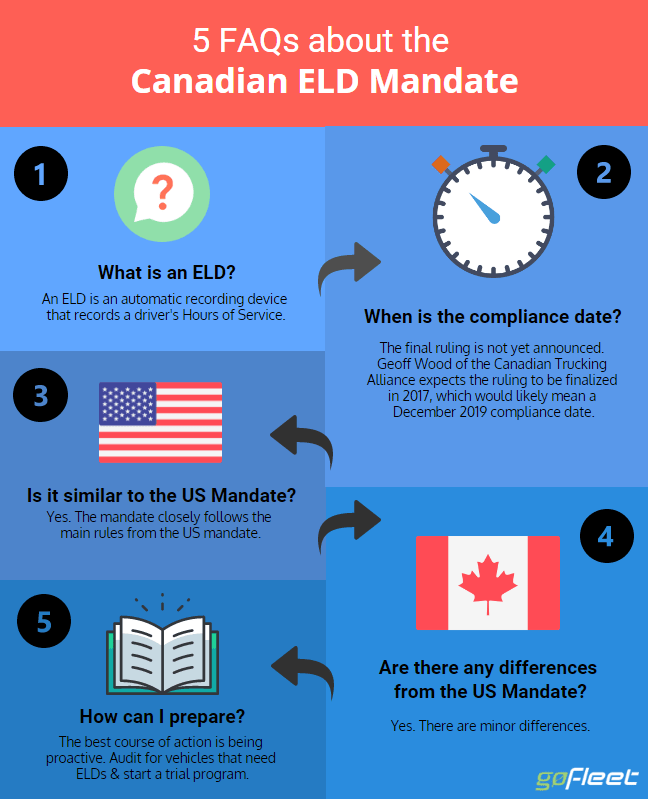5 FAQs About The Canadian ELD Mandate
Transport Canada announced in 2016 that there will be a Canadian ELD Mandate. This rule would require many bus and truck drivers to use electronic logs to report their Records of Duty. It also brings Canadian regulations in line with our American neighbours, who require ELD compliance by December 2017.
Let’s run through some of the frequently asked questions about the Canadian ELD Mandate.
1) What is an ELD and why is it mandated?
An ELD, or electronic logging device, is a device that automatically records Hours of Service (HOS). Drivers are required to complete HOS logs to ensure that they are driving legal shifts.
For a long time, drivers recorded their HOS with paper logs. Paper logs have unfortunately led to hours skimming, where drivers are driving illegal hours while reporting false hours. As a result, an ELD mandate was proposed in the US and in Canada.
2) When will the Canadian ELD Mandate be in effect?
There has not been an official announcement on the Canadian compliance date. However, Canadian companies that travel in the US are required to comply with the FMCSA mandate. That date is December 18th, 2017.
What is the approximate timeline in Canada? Geoff Wood, senior VP of the Canadian Trucking Alliance, expects the mandate to be finalized and issued by the end of 2017. There would likely be a 2-year period to prepare for compliance. This means that the expected Canadian compliance date would be in December 2019. Those using AOBRDs (Automatic Onboard Recording Devices) would have until 2021 to comply.
3) How similar are the Canadian mandate rules with the American mandate rules?
Wood expects the Canadian mandate to be “99.8% in line” with the American mandate. ELD devices compliant with American rules would have no issues in Canada.
Let’s review the US mandate, which will be closely followed in the Canadian version.
- ELDs are required for any drivers who maintain duty status logs on 8+ days on a 30-day period.
- Some exceptions are available for older model vehicles, towaway/driveway vehicles, and RODs no longer than 8 days in any 30-day period.
4) Are there any differences from the Canadian vs. American ELD rules?
Yes, there are some minor differences. Wood outlined some of the most important areas.
Transferring logs when requested by enforcement. In the US, fleets must transfer detailed 8-day log entries. In Canada, fleets can transfer 14-day PDF forms.
Personal use. The US mandate does not have any time nor distance restrictions. In Canada, drivers can mark routes as “personal” routes for the first 75 km. ELDs must then be activated on “driving” status after 75 km.
Deferral of off duty. The Canadian HOS rules allow for deferral of off duty.
Commercial model year cut-off. The Canadian ELD mandate may change the cutoff model year to 1995, instead of 1999 as in the US. This could affect up to 70,000 trucks.
5) How should I prepare for the upcoming regulations?
The best way to prepare is to be proactive. US compliant ELDs will also be compliant with the upcoming Canadian regulation.
A good framework would include:
Audit. Review your fleet and drivers. Compare them with American ELD standards. Those who need ELDs under American rules would also need ELDs under Canadian rules since the two mandates are similar.
Research. There are a lot of ELD solutions in the market. A good idea is to speak to colleagues and to review product demos to get a feel on which system fits business needs.
Pilot. Ultimately, the best way to prepare is to start a pilot program. A good idea is to test a few ELD units. Feedback from both drivers and administrators could be collected before full fleet rollout.
Still have questions? Book a free session with our fleet consultants to help prepare for upcoming regulations.
* Information as of August 24th, 2017 *
Read our comprehesive guide to Canada ELD Mandate 2019!
Sources:
CTV News: Canada to Require Bus & Truck Drivers to Log Hours Electronically
Geotab: ELD Mandate Coming Soon to Canada
Fleet Owner: Canadian Truckers Await Their Own ELD Mandate

